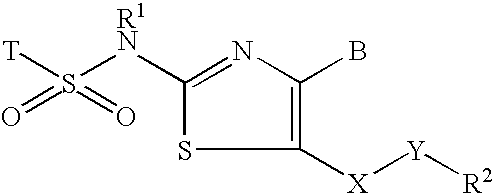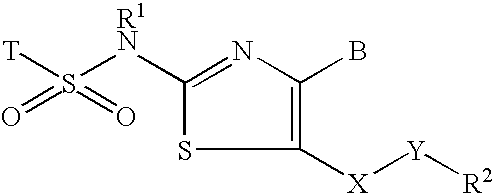Inhibitors of 11-beta-hydroxy steriod dehydrogenase type 1
a technology of steriod dehydrogenase and inhibitors, which is applied in the field of compounds, can solve problems such as excess detrimen
- Summary
- Abstract
- Description
- Claims
- Application Information
AI Technical Summary
Benefits of technology
Problems solved by technology
Method used
Image
Examples
example 1
3-chloro-2-methyl-N-[5-(2-morpholin-4-ylethyl)-1.3-thiazol-2-yl]benzenesulfonamide
Step a—preparation of 2-(2-amino-1.3-thiazol-5-yl)ethanol
[0424] 2,3-dichlorotetrahydroftirane (5 g; 0,035 mol) and thiourea (2,7 g; 0,035 mol) were refluxed for 12 h in water (20 ml). Then 40 ml of 40% NaOH (aq) were added, the reaction mixture was cooled to room temperature and stirred for one hour. The formed precipitate was filtered off, dried at reduced pressure and recrystallized from EtOH / Et2O. HCl, 2M in Et2O, was added to form the HCl-salt which was isolated by filtration and dried. Yielded 3,8 g, 61%.
[0425]1H NMR (400 MHz, DMSO-d6) 8 ppm 2.71 (t, J=4.88 Hz, 2H) 3.53 (t, J=5.62 Hz, 2H) 4.17 (s, 1H) 7.06 (s, 1H) 9.37 (s, 2H). MS m / z: M+H 145
Step b—preparation of 3-chloro-2-methyl-N-[5-(2-morpholin-4-ylethyl)-1.3-thiazol-2-yl]benzenesulfonamide
[0426] 2-(2-amino-1,3-thiazol-5-yl)ethanol (0,16 g; 0,89 mmol), 3-chloro-2-methylbenzenesulfonyl chloride (0,62 g; 2,8 mmol) and NaOH (0,093 g; 2,3 ...
example 2
methyl (2-{[(3-chloro-2-methylphenyl)sulfonyl]amino}-1.3-thiazol-5-yl)acetate
Step a—preparation of methyl 3-bromo-4-oxobutanoate
[0428] Firstly, methyl 4-oxobutanoate was synthesized from the commercially available methyl 4,4-dimethoxybutyrate according to a literature procedure; Will, S. G.; Magriotis, P.; Marinelli, E. R.; Dolan, J.; Johnson, F. J. Org. Chem., 1985, 50, 5433-5434.
[0429] Secondly, methyl 3-bromo-4-oxobutanoate was obtained from methyl 4-oxobutanoate following a literature procedure; Aeberli, M.; Erlenmeyer. H. Hel. Chim. Acta., 1950, 70, 503-505.
Step b—preparation of methyl (2-{[(3-chloro-2-methylphenyl)sulfonyl]amino}-1,3-thiazol-5-yl)acetate
[0430] N-(aminocarbonothioyl)-3-chloro-2-methylbenzenesulfonamide (0.4 g, 1.5 mmol) and methyl 3-bromo-4-oxobutanoate (0.3 g, 1.5 mmol), dissolved in pyridine (5 mL), were irradiated in a microwave oven for 2.5 min at 130° C. The solvent was removed under reduced pressure and the product separated from the starting mater...
example 3
(2-{[(3-chloro-2-methylphenyl)sulfonyl]amino}-1.3-thiazol-5-yl)acetic acid
[0432] To methyl (2-{[(3-chloro-2-methylphenyl)sulfonyl]amino}-1,3-thiazol-5-yl)acetate (Example 2) (0.2 g, 0.55 mmol) dissolved in EtOH (5.5 mL) was added aqueous KOH (0.6 mL, 5.5 M). The reaction mixture was stirred at room temperature for 1 h. The solvent was then removed under reduced pressure and the crude product dissolved in water. The aqueous phase was acidified using conc. HCl so that the product precipitated. Filtration and washing with water (5 mL) afforded 0.2 g, 97% product. The product was used without any further purification.
PUM
| Property | Measurement | Unit |
|---|---|---|
| Electrical conductance | aaaaa | aaaaa |
Abstract
Description
Claims
Application Information
 Login to View More
Login to View More - R&D
- Intellectual Property
- Life Sciences
- Materials
- Tech Scout
- Unparalleled Data Quality
- Higher Quality Content
- 60% Fewer Hallucinations
Browse by: Latest US Patents, China's latest patents, Technical Efficacy Thesaurus, Application Domain, Technology Topic, Popular Technical Reports.
© 2025 PatSnap. All rights reserved.Legal|Privacy policy|Modern Slavery Act Transparency Statement|Sitemap|About US| Contact US: help@patsnap.com



